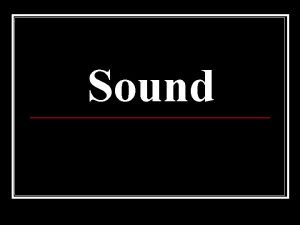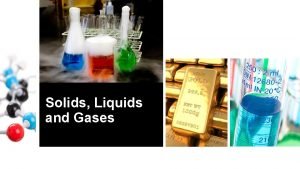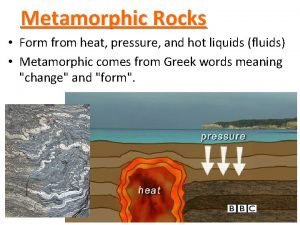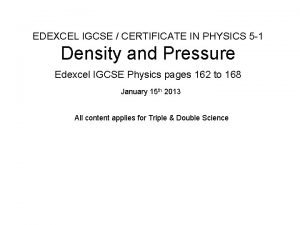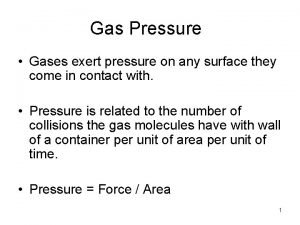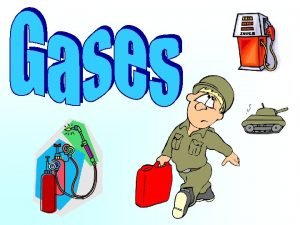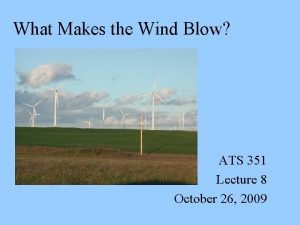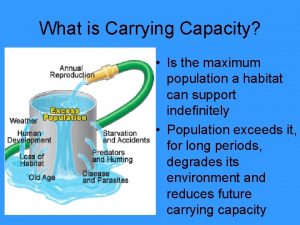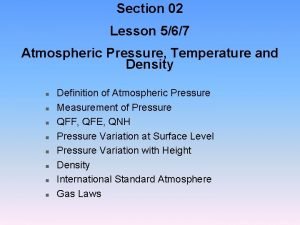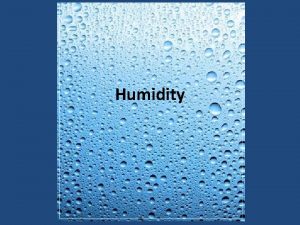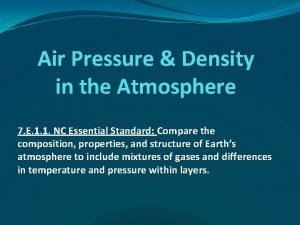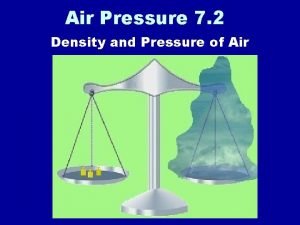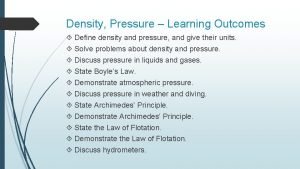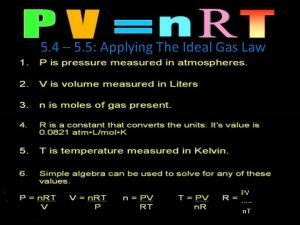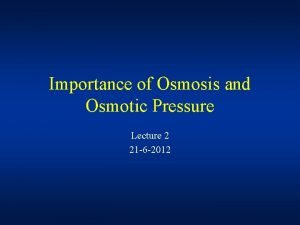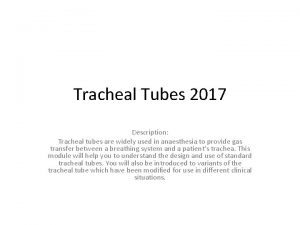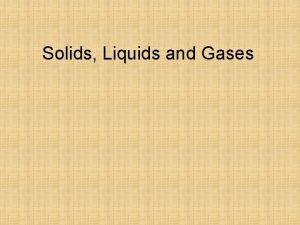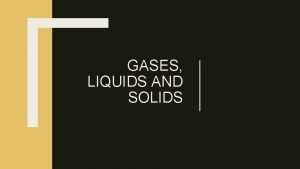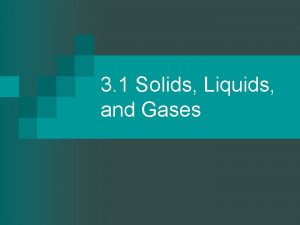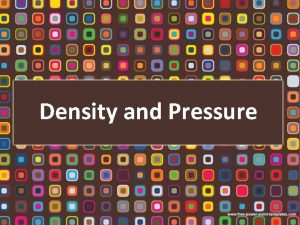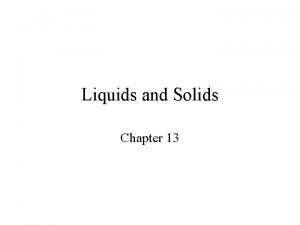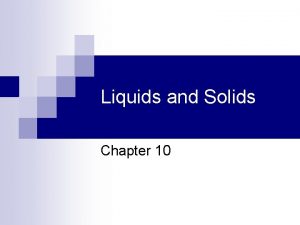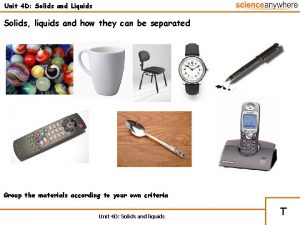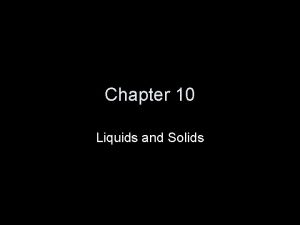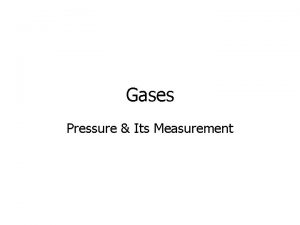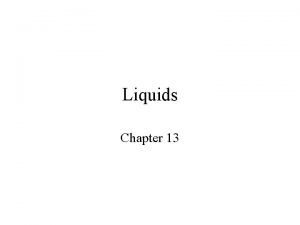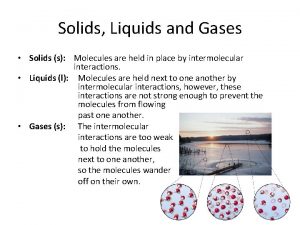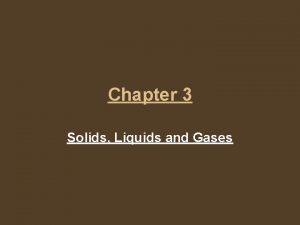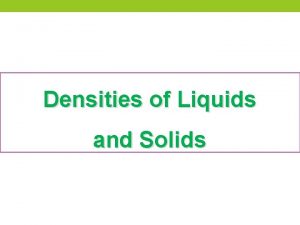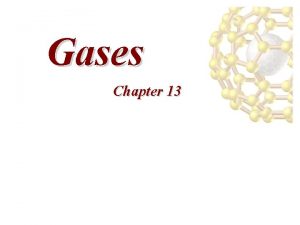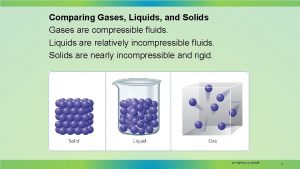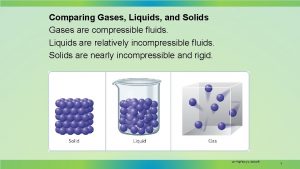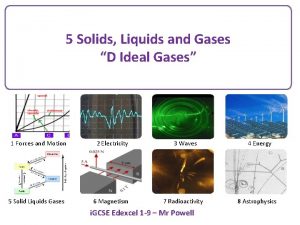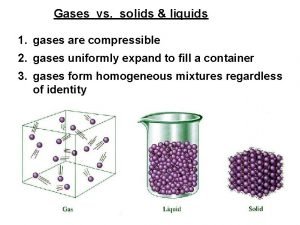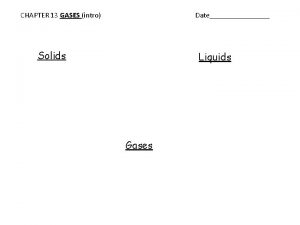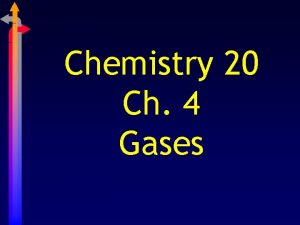DENSITY AND PRESSURE Specification Solids liquids and gases















































- Slides: 47

DENSITY AND PRESSURE

Specification Solids, liquids and gases Density and pressure know and use the relationship: density = mass / volume ρ = m / V describe experiments to determine density using direct measurements of mass and volume know and use the relationship: pressure = force / area p = F / A understand that the pressure at a point in a gas or liquid which is at rest acts equally in all directions know and use the relationship: pressure difference = height × density × g p=h×ρ×g

Measuring the volume of a regular solid V=wxlxh V = π x r 2 x h

Measuring the volume of an irregular solid Smaller solid Larger solid Measure the change in level of the water in a measuring cylinder Measure the volume of water displaced. The string is assumed to have no volume.

Volume units 1 cubic metre (1 m 3) = 1 m x 1 m = 100 cm x 100 cm = 1000 000 cm 3 1 m 3 = 1000 cm 3 NOTE: 1 cubic centimetre (cm 3 OR ‘cc’) is also the same as 1 millilitre (ml)

Density (ρ) density = mass volume ρ=m/V mass, m is measured in kilograms (kg) volume, V is measured in cubic metres (m 3) density, ρ is measured in kilograms per cubic metres (kg/m 3)

also: mass = density x volume and: volume = density volume m ρ V

Conversion between kg/m 3 and g/cm 3 A 1 g mass of water has a volume of 1 cm 3 but 1 g = 0. 001 kg and 1 cm 3 = 0. 000 001 m 3 Therefore: 1 m 3 of water will have a mass of 1000 x 1 g = 1000 kg 1000 kg/m 3 is the same as 1 g/cm 3

Density examples density (kg/m 3) Interstellar space 10 -25 to 10 -15 hydrogen helium air 0. 0989 wood (average) 700 lithium water plastics aluminium 0. 534 density (kg/m 3) 1000 iron lead mercury uranium gold osmium Sun’s core 150 000 850 to 1400 neutron star 1017 2 700 black hole 0. 179 1. 29 7 900 11 300 13 500 19 100 19 300 22 610 > 4 x 1017

Question 1 Calculate the density of a metal block of volume 0. 20 m 3 and mass 600 kg.

Question 1 Calculate the density of a metal block of volume 0. 20 m 3 and mass 600 kg. density = mass volume = 600 kg / 0. 20 m 3 density of the metal = 3000 kg / m 3

Question 2 Calculate the mass of a block of wood of volume 0. 050 m 3 and density 600 kg/m 3.

Question 2 Calculate the mass of a block of wood of volume 0. 050 m 3 and density 600 kg/m 3. ρ=m/V becomes: m=ρx. V = 600 kg/m 3 x 0. 050 m 3 mass of wood = 30 kg

Question 3 Calculate the volume of a liquid of mass 45 kg and density 900 kg/m 3. ρ=m/V becomes: V=m/ρ = 45 kg ÷ 900 kg/m 3 volume of liquid = 0. 05 m 3

Question 4 When a small stone is immersed into the water inside a measuring cylinder the level increases from 20. 0 to 27. 5 ml. Calculate the density of the stone in g/cm 3 if its mass is 60 g.

Question 4 When a small stone is immersed into the water inside a measuring cylinder the level increases from 20. 0 to 27. 5 ml. Calculate the density of the stone in g/cm 3 if its mass is 60 g. Volume of stone = (27. 5 – 20. 0) ml = 7. 5 cm 3 ρ=m/V = 60 g / 7. 5 cm 3 density of the stone = 8. 0 g/cm 3

Question 5 Calculate the density in g/cm 3 and kg/m 3 of a metal cylinder of radius 2 cm, height 3 cm and mass 400 g.

Question 5 Calculate the density in g/cm 3 and kg/m 3 of a metal cylinder of radius 2 cm, height 3 cm and mass 400 g. Volume of a cylinder = π x r 2 x h = π x (2 cm)2 x 3 cm = 3. 142 x 4 x 3 = 37. 7 cm 3 ρ=m/V = 400 g / 37. 7 cm 3 metal density = 10. 6 g/cm 3 = 10 600 kg/m 3

Question 6 Calculate the mass of a teaspoon full (1 cm 3) of a neutron star. Density of a neutron star = 1. 0 x 1017 kg/m 3.

Question 6 Calculate the mass of a teaspoon full (1 cm 3) of a neutron star. Density of a neutron star = 1. 0 x 1017 kg/m 3. 1. 0 cm 3 = 0. 0001 m 3 ρ=m/V becomes: m=ρx. V = 1. 0 x 1017 kg/m 3 x 0. 0001 m 3 mass = 1. 0 x 1011 kg Note: 1 tonne = 1000 kg = 1. 0 x 103 kg Therefore mass = one hundred million tonnes!

Choose appropriate words to fill in the gaps below: Density is equal to ______ divided by _____ and can be measured in kilograms per ______ metres. A density of _______kg/m 3 is the same as a density of 1 g/cm 3. This is the density of ____. The ____ of a stone can be measured by immersing the stone into water. The volume of water ____ by the stone is equal to the volume of the stone. The volume of the water displaced is found using a _____ cylinder. WORD SELECTION: cubic density 1000 mass water measuring displaced volume

Answers: volume mass divided by _____ Density is equal to ______ and can be cubic metres. measured in kilograms per ______ 3 is the same as a density of 1 g/cm 3. 1000 A density of _______kg/m water This is the density of ____. density of a stone can be measured by immersing the The ____ displaced by the stone is stone into water. The volume of water ____ equal to the volume of the stone. The volume of the water measuring cylinder. displaced is found using a _____ WORD SELECTION: cubic density 1000 mass water measuring displaced volume

Pressure, p pressure = force area p=F A units: force, F – newtons (N) area, A – metres squared (m 2) pressure, p – pascals (Pa)

also: force = pressure x area and: area = F force pressure p A Note: 1 Pa is the same as 1 newton per square metre (N/m 2)

Question 1 Calculate the pressure exerted by a force of 200 N when applied over an area of 4 m 2. p=F/A = 200 N / 4 m 2 pressure = 50 Pa

Question 2 Calculate the force exerted by a gas of pressure 150 000 Pa on an object of surface area 3 m 2.

Question 2 Calculate the force exerted by a gas of pressure 150 000 Pa on an object of surface area 3 m 2. p=F/A becomes: F=px. A = 150 000 Pa x 3 m 2 force = 450 000 N

Question 3 Calculate the area that will experience a force of 6000 N from a liquid exerting a pressure of 300 k. Pa.

Question 3 Calculate the area that will experience a force of 6000 N from a liquid exerting a pressure of 300 k. Pa. p=F/A becomes: A=F/p = 6000 N ÷ 300 k. Pa = 6000 N ÷ 300 000 Pa area = 0. 02 m 2

Complete: force area pressure 40 N 8 m 2 500 N m 2 25 Pa N 5 m 2 80 Pa 20 N 2 cm 2 k. Pa 6 N mm 2 3 MPa Pa

Complete: force area pressure 40 N 8 m 2 5 Pa 500 N 20 m 2 25 Pa 400 N 5 m 2 80 Pa 20 N 2 cm 2 100 k. Pa 6 N 2 mm 2 3 MPa

Pressure exerted by a block question The metal block, shown opposite, has a weight of 900 000 N. Calculate the maximum and minimum pressures it can exert when placed on one of its surfaces. Maximum pressure occurs when the block is placed on its smallest area surface (2 m x 3 m) p=F/A = 900 000 N / 6 m 2 Maximum pressure = 150 000 Pa Minimum pressure occurs when the block is placed on its largest area surface (3 m x 5 m) p=F/A = 900 000 N / 15 m 2 Minimum pressure = 60 000 Pa 2 m 3 m 5 m

Pressure examples Space (vacuum) Air pressure at the top of Mount Everest Average pressure of the Earth’s atmosphere at sea level at 0°C Typical tyre pressure Pressure 10 m below the surface of the sea Estimated pressure at the depth (3. 8 km) of the wreck of the Titanic pressure in Pa or N/m 2 0 30 000 101 325 180 000 200 000 41 000

Pressure exerted by a person on a floor 1. Weigh the person in newtons. This gives the downward force, F exerted on the floor. 2. Draw, on graph paper, the outline of the person’s feet or shoes. 3. Use the graph paper outlines to calculate the area of contact, A with the floor in metres squared. (Note: 1 m 2 = 10 000 cm 2) 4. Calculate the pressure in pascals using: p = F / A

Typical results 500 N 1. Weight of person: _____ 2. Outline area of both 60 feet in cm 2 ____ 3. Outline area of both 0. 006 feet in m 2 _____ 500 N 4. Pressure = ____ 0. 006 m 2 83 000 Pa = _______

Why off-road vehicles have large tyres or tracks In both cases the area of contact with the ground is maximised. This causes the pressure to be minimised as: pressure = vehicle weight ÷ area Lower pressure means that the vehicle does not sink into the ground.

How a gas exerts pressure • A gas consists of molecules in constant random motion. • When a molecule collides with a surface it reverses direction due to the force exerted on it by the surface. • The molecule in turn exerts a force back on the surface. • The pressure exerted by the gas is equal to the total force exerted by the molecules on a particular area of the surface divided by the area. • pressure = force / area

Pounds per square inch (psi) Often used to measure car tyre pressures. 1 psi = 6895 Pa 1 atm = 101 k. Pa = 14. 7 psi tyre pressure gauge Inches of mercury (in. Hg) Often found on domestic barometers. 1 in. Hg = 3386 Pa 1 atm = 101 k. Pa = 29. 9 in. Hg Examples: Fair weather – high pressure: 30. 5 in. Hg Rain – low pressure: 29. 0 in. Hg

Pressure in liquids and gases The pressure in a liquid or a gas at a particular point acts equally in all directions. At the same depth in the liquid the pressure is the same in all directions

The pressure in a liquid or a gas increases with depth The pressure of the liquid increases with depth

Pressure, height or depth equation pressure difference = height × density × g p=h×ρ×g units: height or depth, h – metres (m) density, ρ – kilograms per metres cubed (kg/m 3) gravitational field strength, g – newtons per kilogram (N/kg) pressure difference, p – pascals (Pa)

Question 1 Calculate the pressure increase at the bottom of a swimming pool of depth 2 m. Density of water = 1000 kg/m 3 g = 10 N/kg

Question 1 Calculate the pressure increase at the bottom of a swimming pool of depth 2 m. Density of water = 1000 kg/m 3 g = 10 N/kg pressure difference = h × ρ × g = 2 m x 1000 kg/m 3 x 10 N/kg pressure increase = 20 000 Pa

Question 2 At sea level the atmosphere has a density of 1. 3 kg/m 3. (a) Calculate thickness (height) of atmosphere required to produce the average sea level pressure of 100 k. Pa. (b) Why is the actual height much greater? g = 10 N/kg

Question 2 At sea level the atmosphere has a density of 1. 3 kg/m 3. (a) Calculate thickness (height) of atmosphere required to produce the average sea level pressure of 100 k. Pa. (b) Why is the actual height much greater? g = 10 N/kg (a) p = h × ρ × g becomes: h = p / (ρ × g) = 100 k. Pa / (1. 3 kg/m 3 x 10 N/kg) = 100 000 / (1. 3 x 10) = 100 000 / 13 height = 7 692 m (7. 7 km) (b) The real atmosphere’s density decreases with height. The atmosphere extends to at least a height of 100 km.

Choose appropriate words to fill in the gaps below: Pressure is equal to _______ divided by ______. Pressure is measured in _______ (Pa) where one pascal is the same as one newton per ____ metre. The pressure of the Earth’s ______ at sea-level is approximately 100 000 Pa. Pressure increases with ______ below the surface of liquid. Under _______ the pressure increases by about one atmosphere for every ______ metres of depth. WORD SELECTION: square depth force water area ten atmosphere pascal

Choose appropriate words to fill in the gaps below: area force Pressure is equal to _______ divided by ______. pascal (Pa) where one pascal is the Pressure is measured in _______ square same as one newton per ____ metre. atmosphere at sea-level is The pressure of the Earth’s ______ approximately 100 000 Pa. depth below the surface of liquid. Pressure increases with ______ water the pressure increases by about one Under _______ ten atmosphere for every ______ metres of depth. WORD SELECTION: square depth force water area ten atmosphere pascal
 Expansion of solids liquids and gases examples
Expansion of solids liquids and gases examples Buoyancyability
Buoyancyability Venn diagram of matter
Venn diagram of matter Properties of solid
Properties of solid Combined gas law def
Combined gas law def Lesson outline lesson 1 solids liquids and gases answer key
Lesson outline lesson 1 solids liquids and gases answer key Chapter 14 solids liquids and gases worksheet answers
Chapter 14 solids liquids and gases worksheet answers Kinetic molecular theory of solid
Kinetic molecular theory of solid Particle movement in solids liquids and gases
Particle movement in solids liquids and gases How does sound travel through solids liquids and gases
How does sound travel through solids liquids and gases Properties of solid liquid and gas
Properties of solid liquid and gas Motion of particles in solids, liquids and gases
Motion of particles in solids, liquids and gases Why are gases easier to compress than solids or liquids
Why are gases easier to compress than solids or liquids Solid liquid and gas particles
Solid liquid and gas particles Adhesive force
Adhesive force Liquids and solids menu
Liquids and solids menu Kesler science.com
Kesler science.com Chapter 11 - states of matter: liquids and solids
Chapter 11 - states of matter: liquids and solids Molecular theory of gases and liquids
Molecular theory of gases and liquids Filtering solids from liquids
Filtering solids from liquids If lclp is negative number, we set the lclp = 0. why?
If lclp is negative number, we set the lclp = 0. why? Upper specification limit and lower specification limit
Upper specification limit and lower specification limit Parent rock of quartzite
Parent rock of quartzite G(r)
G(r) Bcc 111 planar density
Bcc 111 planar density Linear density and planar density
Linear density and planar density P= f/a
P= f/a Do gases exert pressure on whatever surrounds them
Do gases exert pressure on whatever surrounds them Do gases exert pressure on whatever surrounds them
Do gases exert pressure on whatever surrounds them What does arithmetic density tell us
What does arithmetic density tell us High density low density
High density low density What is physiological density ap human geography
What is physiological density ap human geography Relationship between air pressure and density
Relationship between air pressure and density Relationship between air pressure and density
Relationship between air pressure and density Relationship between air pressure and density
Relationship between air pressure and density Relationship between air pressure and density
Relationship between air pressure and density Relationship between air pressure and density
Relationship between air pressure and density Relationship between air pressure and density
Relationship between air pressure and density What pressure
What pressure Pressure density
Pressure density Sheath plasma
Sheath plasma Calculate the density of xenon gas at a pressure of 742
Calculate the density of xenon gas at a pressure of 742 Bernoulli rule of integration
Bernoulli rule of integration Oncotic pressure
Oncotic pressure High pressure and low pressure
High pressure and low pressure Low atmospheric pressure
Low atmospheric pressure Patella type 3
Patella type 3 Pressure support vs pressure control
Pressure support vs pressure control









